Sebastian Mary and i were talking last week about the need to re-conceive the format of if:book so that interesting posts which initiate lively discussions don’t get pushed to the bottom. a few days later i met with Rene Daalder who showed me his new site, Space Collective which is a gorgeous and brilliant re-thinking of the blog. click on “new posts” and notice how you can view them by “Recently Active, Most Popular, Newest First, and Most Active.” Also notice the elegant way individual posts emerge from the pack when you click on one of them. Please, if you know of other sites which are exploring new directions for the blog, please put the URL into a comment on this post.
Category Archives: time
texts over time
There’s a striking passage in “The Folio Restored”, an article by Jonathan Bate in the April 20 issue of the Times Literary Supplement on the perils of editing Shakespeare because of the differences between various editions:
“Perhaps it would be best to abandon the idea that any one text represents the ‘definitive’ version of a Shakespeare play. After all, the quest for a ‘definitive’ text, based on a ‘single lost original’, was premissed on the principles of Classical and biblical textual criticism. It is not necessarily appropriate for more modern literary and, especially, dramatic texts. ‘Version-based editing’ now seems a more fitting way of approaching authors (such as Wordsworth in The Prelude, or Henry James in the New York Edition of his novels) who self-consciously revised their word. Theatre is a supremely mobile art form, and we need a similar version-based approach to Shakespeare. We cannot be confident about the degree of authorial control in the revision of Shakespeare’s plays, or the extent to which it was systematic or haphazard; but we can be confident that many of the thousands of differences between the quarto and Folio texts are best explained by accepting that the texts embody different moments in those plays’ theatrical lives.”
(p. 12 of the 20 April 2007 issue; online here, though their archive is subscriber-only.) I don’t think you need to be interested in the details of textual minutiae to see that this is an interesting way of thinking about texts, and especially about how they can function in a digital age. Texts might be thought of as souls metempsychosing through bodies, temporarily alighting in books as they pass through time.
blogs and time (links for 11.1.06)
Interesting links that crossed my path over the past few days that I haven’t time to post on (and likely never will):
- “French publishers join fight against Google Book Search”: Le Syndicat National de l’édition (SNE), a trade association of French publishers, has joined a suit brought against Google by the Le Martiniè re conglomerate in August for “counterfeiting and breach of intellectual property rights” in its book digitization program.
- outside.in is a new web service co-created by Steven Johnson and John Geraci that aggregates blog content according to zip code, giving you a regularly updated guide to where you live. It uses a little Google map as a navigation tool — a dynamic table of contents.
- US intelligence agencies use wikis: The CIA and other agencies have begun using an internal wiki site called the “Intellipedia” where staff post current events updates and colloborate on intelligence assessments, supposedly to avoid repeating mistakes like Iraq WMD. “‘I think in the future you’ll press a button and this will be the NIE,’ said Michael Wertheimer, assistant deputy director of national intelligence for analysis.”
- Clay Shirky on “meganiches”
- Wikipedia and the academy: To contribute or not to contribute? Article in Chronicle of Higher Ed. on the fraught relationship between academics and the online encyclopedia. Among other things discusses troubling disparity in quality between science articles and humanities articles. Is there a “two cultures” problem in online scholarly collaboration?
- Ehon: The Artist and the Book in Japan: Glorious exhibit at the New York Public Library. A totally different way of thinking about books.
Should if:book serve as a filter and recommender, providing nutritious lists of links like the one above, or purely as a source of original ideas and commentary? If the answer is both, then what should be the ratio of shorter, “pointier” posts to longer, “thinkier” ones? Blogs are agnostic as to the varying size and speed of thoughts — everything goes into the same sinking scroll, soon vanishing into the catacombs of the monthly archives and category pages.
This works fine for news cycle or daily diary-type blogs, but it’s a handicap for a site like ours where longer meditations — the kind that would benefit from longer exposure — are the more common fare, and where extended, multi-post arcs on a relatively small cluster of central ideas are more what constitute the “story” of this blog than any given week’s smattering of entries. As I write, there are several extended conversations taking place within posts that, though only a few days old, are being pushed further and further down the scroll as newer content accumulates. The only hint of their still being active is the “recent comments” link to the right, which is at best an overheard whisper.
Given these constraints, and figuring that it’s the slower moving ideas that matter most, we generally try to avoid posting quick linkdumps like the one above — useful as they might be for annotating our wider web readings and pointing readers to interesting sites — simply because they have the unfortunate effect of pushing the other stuff down. But this only slightly mitigates the still unsolved problem of portraying complex movements of ideas over time on a dinky little blog.
As a side project, we’re thinking about how we could redesign if:book to keep the thinky stuff visible for longer and tied to past related discussions, while also keeping a swift current of useful annotated links and shorter observational posts. This might mean dividing our content into two separate feeds, as on this site.
We’ve also thought about ways to organize content thematically rather than temporally, so what you see at the top isn’t just the newest content, but a cluster of our most important and long-abiding conversations arranged by subject. We’re also considering changes to the individual permalinked pages of posts, perhaps adding dynamically generated links to related posts.
We’ve played around a bit with thematic arrangements on Mitch Stephens’ blog Without Gods. First, just below his banner there’s this tag cloud, which serves as a mental map of Mitch’s writing and interests:
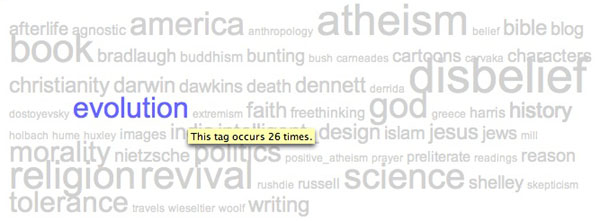
Then there are four side menus with recent posts divided up by general area. “Bonner’s Field” is current events, “Tales of Disbelief” deals with characters in his book, “Thinking Out Loud” is sort of free-form jamming on ideas, and “Book Writer’s Journal” is meta-commentary on the writing process:
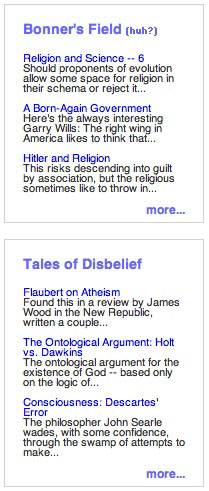
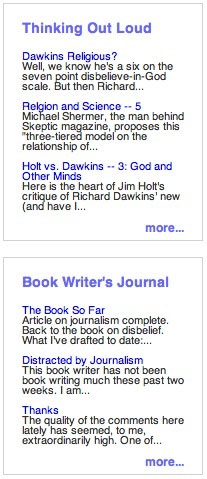
I’m also very taken with what this site, an NYU webzine on media and religion called The Revealer. They have a lovely section on the front page that divides articles and blog postings into three distinct tempos, or traffic lanes (which brings us back to the multiple streams/feeds idea):
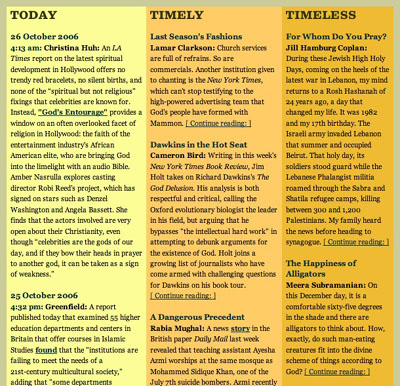
“Time signature” is something we need to add to our design vocabulary for dealing with evolutionary, never-finished documents. Having multiple rates of movement in a single space can create interesting tensions and provide more points of entry to for the reader. I’m hoping we can put some of this into practice with if:book, and soon.
What are other sites that do a good job of handling time? Any other ideas as to how we might do better here?
sharing goes mainstream
 Ben’s post on the Google book project mentioned a fundamental tenet of the Institute: the network is the environment for the future of reading and writing, and that’s why we care about network-related issues. While the goal of the network isn’t reducable to a single purpose, if you could say it was any one thing it would be: sharing. It’s why Tim Berners-Lee created it in the first place—to share scientific research. It’s why people put their lives on blogs, their photos on flickr, their movies on YouTube. And it is why the people who want to sell things are so anxious about putting their goods online. The bottom line is this: the ‘net is about sharing, that’s what it’s for.
Ben’s post on the Google book project mentioned a fundamental tenet of the Institute: the network is the environment for the future of reading and writing, and that’s why we care about network-related issues. While the goal of the network isn’t reducable to a single purpose, if you could say it was any one thing it would be: sharing. It’s why Tim Berners-Lee created it in the first place—to share scientific research. It’s why people put their lives on blogs, their photos on flickr, their movies on YouTube. And it is why the people who want to sell things are so anxious about putting their goods online. The bottom line is this: the ‘net is about sharing, that’s what it’s for.
Time magazine had an article in the March 20th issue on open-source and innovation-at-the-edges (by Lev Grossman). Those aren’t new ideas around office, but when I saw the phrase the “authorship of innovation is shifting from the Few to the Many” I realized that, for the larger public, they are still slightly foreign, that the distant intellectual altruism of the Enlightenment is being recast as the open-source movement, and that the notion of an intellectual commons is being rejuvenated in the public consciousness. True, Grossman puts out the idea of shared innovation as a curiosity—it’s a testament to the momentum of our contemporary notions of copyright that the cultural environment is antagonistic to giving away ideas—but I applaud any injection of the open-source ideal into the mainstream. Especially ideas like this:
Admittedly, it’s counterintuitive: until now the value of a piece of intellectual property has been defined by how few people possess it. In the future the value will be defined by how many people possess it.
I hope the article will seed the public mind with intimations of a world where the benefits of intellectual openness and sharing are assumed, rather than challenged.
Raising the public consciousness around issues of openness and sharing is one of the goals of the Institute. We’re happy to have help from a magazine with Time’s circulation, but most of all, I’m happy that the article is turning public attention in the direction of an open network, shared content, and a rich digital commons.
LONGPLAYER
when i was growing up they started issuing LP albums which played at 33 1/3 rpm, vastly increasing the amount of playing time on one side of a record. before the LP, audio was recorded and distributed on brittle discs made of shellac, running at 78rpm. 78s had a capacity of about 12 minutes; LPs upped that to about 30 minutes which made it possible for classical music fans to listen to an entire movement without changing discs and enabled 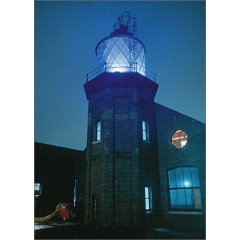 the development of the rock and roll album.
the development of the rock and roll album.
in 2,000 Jem Finer, a UK-based artist released Longplayer, a 1000-year musical composition that runs continuously and without repetition from its start on January 1, 2000 until its completion on December 31, 2999. Related conceptually to the Long Now project which seeks to build a ten-thousand year clock, Longplayer uses generative forms of music to make a piece that plays for ten to twelve human lifetimes. Longplayer challenges us to take a longer view which takes account of the generations that will come after us.
the longplayer also reminds me of an idea i’ve been intrigued by — the possiblity of (networked) books that never end because authors keep adding layers, tangents and new chapters.
Finer published a book about Longplayer which includes a vinyl disc (LP actually) with samples.
phone photo of london underground nominated for time best photo; photo agency claims credit for creative commons work
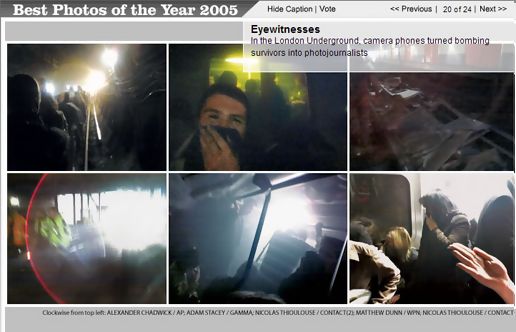
Moblog co-founder Alfie Dennen is furious that the photo agency Gamma has claimed credit for a well-known photo of last summer’s London subway bombing –first circulated on Moblog under a Creative Commons liscence — that was chosen for Time’s annual Best Photo contest. Dennen and others in the blogosphere are hoping that photographer Adam Stacey might take legal action against Gamma for what seems to be a breach of copyright.
We at the Institute are still trying to figure out what to make of this. Like everyone else who has been observing the increasing popularity of the Creative Commons license, we’ve been wondering when and how the license will be tested in court. However, this might not be the best possible test case. On one hand, it seems to be a somewhat imperious “claiming” of a photo widely celebrated for being produced by a citizen journalist who was committed to its free circulation. One the other hand, it seems unclear whether Dennen and/or Stacey are correct in their assertion that the CC license that was used really prohibits Gamma from attaching their name to the photo.
The photo in question, a shot of gasping passengers evacuating the London Underground in the moments after last summer’s bombing (in the image above, it’s the second photo clockwise), was snapped by Stacey using the camera on his cellphone. Time’s nomination of the photo most likely reflects the fact that the photo itself — and Stacey — became something of a media phenomenon in the weeks following the bombing. The image was posted on Moblog about 15 minutes after the bombing, and then widely circulated in both print and online media venues. Stacey subsequently appeared on NPR’s All Things Considered, and the photo was heralded as a signpost that citizen journalism had come into its own.
While writing about the photo’s appearance in Time, Dennen noticed that Time had credited the photo to Adam Stacey/Gamma instead of Adam Stacey/Creative Commons. According to Dennen, Stacey had been contacted by Gamma and had turned down their offer to distribute the photo, so the attribution came as an unpleasant shock. He claims that the license chosen by Stacey clearly indicates that the photo be given Creative Commons attribution. But is this really clear? The photo is attributed to Stacey, but not to Creative Commons: does this create a grey area? The license does allow commercial use of Stacey’s photo, so if Gamma was making a profit off the image, that would be legal as well.
Dennen writes on his weblog that he contacted Gamma for an explanation, arguing that after Stacey told the agency that he wanted to distribute the photo through Creative Commons, they should have understood that they could use it, but not claim it as their own. Gamma responded in an email that, “[we] had access to this pix on the web as well as anyone, therefore we downloaded it and released it under Gamma credit as all agencies did or could have done since there was no special requirement regarding the credit.” They also claimed that in their conversation with Stacey, Creative Commons never came up, and that a “more complete answer” to the reason for the attribution would be available after January 3rd, when the agent who spoke with Stacey returned from Christmas vacation.
Until then, it’s difficult to say whether Gamma’s claim of credit for the photo is accidental or deliberate disregard. Dennen also says that he’s contacting Time to urge them to issue a correction, but he hasn’t gotten a response yet. I’ll follow this story as it develops.
mothlight
i. the text of light
 The filmmaker Stan Brakhage is one of those people whose work hangs in the back of my mind with a frequency well out of proportion to my actually engaging with his work. I first (and really, only, until recently) saw his films about seven years ago, when he introduced a marathon screening of what must have been almost his complete works. Hours later, I stumbled out of the theatre, knowing that this was someone whose work I should have seen years before, having seen on the screen something new to me, a new way of looking at the possibility of film. I’ve felt an analogous sensation with only a handful of artists and writers; I’ve found it again in the luminously fractured English of Amos Tutuola, Ray Johnson’s conceptual games of “correspondance”, and Michel Butor’s reimagining of the page and narrative.
The filmmaker Stan Brakhage is one of those people whose work hangs in the back of my mind with a frequency well out of proportion to my actually engaging with his work. I first (and really, only, until recently) saw his films about seven years ago, when he introduced a marathon screening of what must have been almost his complete works. Hours later, I stumbled out of the theatre, knowing that this was someone whose work I should have seen years before, having seen on the screen something new to me, a new way of looking at the possibility of film. I’ve felt an analogous sensation with only a handful of artists and writers; I’ve found it again in the luminously fractured English of Amos Tutuola, Ray Johnson’s conceptual games of “correspondance”, and Michel Butor’s reimagining of the page and narrative.
 But Brakhage. His films tend to be short and silent. His editing, if it can be called such, is quick – often an image only shows for a frame, then it’s gone. In most of his films, he cuts quickly between shots; in some of his work he abandoned the camera entirely to work directly with the film stock itself, painting on it or gluing things to it. Jean-Luc Godard said that the cinema was the truth twenty-four times a second; rarely has this been so literally explicated as in Brakhage’s films. Mitchell Stephens, in The Rise of the Image, the Fall of the Word saw in the lighting-fast editing style that Brakhage introduced a possible future for communication. But Brakhage was following his own very particular muse. His aim, he declared in one of his later films, was to show on film what the eye sees when it is closed, the phenomenon of dancing spots of color that’s been termed hypnogogic vision.
But Brakhage. His films tend to be short and silent. His editing, if it can be called such, is quick – often an image only shows for a frame, then it’s gone. In most of his films, he cuts quickly between shots; in some of his work he abandoned the camera entirely to work directly with the film stock itself, painting on it or gluing things to it. Jean-Luc Godard said that the cinema was the truth twenty-four times a second; rarely has this been so literally explicated as in Brakhage’s films. Mitchell Stephens, in The Rise of the Image, the Fall of the Word saw in the lighting-fast editing style that Brakhage introduced a possible future for communication. But Brakhage was following his own very particular muse. His aim, he declared in one of his later films, was to show on film what the eye sees when it is closed, the phenomenon of dancing spots of color that’s been termed hypnogogic vision.
 Mothlight, stills from which can be seen floating about this post, was one of the films that stuck most clearly in my mind. In it, Brakhage set out to show “what a moth might see from birth to death if black were white and white were black.” The ratio of the size of the moth to that of ourselves is roughly that of the size of a film negative to the blown up film; with this in mind, and a collection of dead moths that had flown into a light and perished, Brakhage composed a three-minute film, every frame of which is composed of things from the moth’s world: wings, plant leaves, and flowers. Brakhage pasted these objects directly onto the film stock. When the film is projected there’s a rush of images made unfamiliar by size: a moth wing or a flower twenty feet wide is something we’ve never seen before. Though constructed of objects that we imagine we know, the moth’s world as Brakhage depicts it is utterly foreign to us. Speed has a lot to do with it: the eye can’t possibly process twenty-four different images per second. The moth’s world is much faster than our own.
Mothlight, stills from which can be seen floating about this post, was one of the films that stuck most clearly in my mind. In it, Brakhage set out to show “what a moth might see from birth to death if black were white and white were black.” The ratio of the size of the moth to that of ourselves is roughly that of the size of a film negative to the blown up film; with this in mind, and a collection of dead moths that had flown into a light and perished, Brakhage composed a three-minute film, every frame of which is composed of things from the moth’s world: wings, plant leaves, and flowers. Brakhage pasted these objects directly onto the film stock. When the film is projected there’s a rush of images made unfamiliar by size: a moth wing or a flower twenty feet wide is something we’ve never seen before. Though constructed of objects that we imagine we know, the moth’s world as Brakhage depicts it is utterly foreign to us. Speed has a lot to do with it: the eye can’t possibly process twenty-four different images per second. The moth’s world is much faster than our own.
The memory of that flicker of images has stayed with me, as much for its ephemerality as anything else: I’d seen something briefly, not long enough to remember the images themselves, but long enough to remember the film more clearly than nearly anything else I saw that year.
ii. the act of seeing with one’s own eyes
 The Criterion Collection released a two-DVD set of some of Brakhage’s films a few years ago, a year or so before he passed away and was briefly in the news again. I’m not sure why I held off buying a copy of the DVD: maybe a devotion to the ephemerality of memory? I did convince an old roommate, a painter, to buy his own copy soon after it was released: independently, he had been trying to capture with oils hypnogogic visions of his own. But I didn’t get a copy until a few weeks ago, when after finding him again in Mitchell Stephens’s book, I broke down for an online Christmas DVD sale. It arrived, and I inserted one of the discs into my Powerbook, curious to see how his films compared to my memory of them.
The Criterion Collection released a two-DVD set of some of Brakhage’s films a few years ago, a year or so before he passed away and was briefly in the news again. I’m not sure why I held off buying a copy of the DVD: maybe a devotion to the ephemerality of memory? I did convince an old roommate, a painter, to buy his own copy soon after it was released: independently, he had been trying to capture with oils hypnogogic visions of his own. But I didn’t get a copy until a few weeks ago, when after finding him again in Mitchell Stephens’s book, I broke down for an online Christmas DVD sale. It arrived, and I inserted one of the discs into my Powerbook, curious to see how his films compared to my memory of them.
 Watching him the first time, I’d been supine before the screen. Watching him on my laptop was something different, something surprising. My first impulse after starting one of the films playing was the obvious one when something’s going too fast, but not an option that one has when you’re part of an audience: to hit the pause button. The moth wings, spider webs, flowers, and blades of grass instantly snap into startling focus: around every object, you can see the halo of glue that Brakhage used to hold it to the celluloid. Then another pleasant surprise: on the Apple DVD player, if you then press the right arrow button, you can advance one frame. Not another frame in the same shot, as one would expect in an ordinary film, but another image entirely, though sometimes, you realize, a connected object: in some frames one sees the top of a plant leaf, in the following, the bottom, exactly as Brakhage constructed the film. (Images of the film stock itself – not just screencaptures from the DVD – can be seen at critic Fred Camper’s website, which offers a dizzying amount of information on Stan Brakhage.)
Watching him the first time, I’d been supine before the screen. Watching him on my laptop was something different, something surprising. My first impulse after starting one of the films playing was the obvious one when something’s going too fast, but not an option that one has when you’re part of an audience: to hit the pause button. The moth wings, spider webs, flowers, and blades of grass instantly snap into startling focus: around every object, you can see the halo of glue that Brakhage used to hold it to the celluloid. Then another pleasant surprise: on the Apple DVD player, if you then press the right arrow button, you can advance one frame. Not another frame in the same shot, as one would expect in an ordinary film, but another image entirely, though sometimes, you realize, a connected object: in some frames one sees the top of a plant leaf, in the following, the bottom, exactly as Brakhage constructed the film. (Images of the film stock itself – not just screencaptures from the DVD – can be seen at critic Fred Camper’s website, which offers a dizzying amount of information on Stan Brakhage.)
Technically, this is not very exciting at all: pausing to see a crisp frame is just one of the niceties of the DVD that we’re all used to. But what this does to the viewer’s experience of the film is immeasurable. Instead of the imposed stricture of watching the images projected at 24 frames per second, you’re free to proceed through Brakhage’s frames at any rate you like – his film becomes something like a slide show. As great a change, though, is imparted to the viewer, who goes from being a passive recipient of speeding images to an active participant with control over what’s being shown.
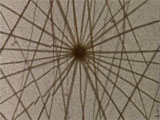 This isn’t, it’s worth pausing to consider, something that would have been possible with a VHS tape. Video didn’t respect the frames of film, and a paused VHS tape generally gives you a blurred and indistinct image. Presumably with a projector and a copy of the original films, you could do the same thing. (This would also resolve the incongruity of looking at images that are meant to have light projected through them rather than being composed of red, green, and blue blips of it, as on my computer screen.) Alas, not many of us have our own movie theater to try this out in. For the rest of us, this amount of control is something that arrives with new digital media, and deserves to be considered as a function of it.
This isn’t, it’s worth pausing to consider, something that would have been possible with a VHS tape. Video didn’t respect the frames of film, and a paused VHS tape generally gives you a blurred and indistinct image. Presumably with a projector and a copy of the original films, you could do the same thing. (This would also resolve the incongruity of looking at images that are meant to have light projected through them rather than being composed of red, green, and blue blips of it, as on my computer screen.) Alas, not many of us have our own movie theater to try this out in. For the rest of us, this amount of control is something that arrives with new digital media, and deserves to be considered as a function of it.
From time to time, Bob talks to the programmers busy making Sophie about imagining film as being a book that’s flipping through 86,400 pages per hour. This sort of talk tends to throw them into conniptions (to paraphrase: nobody in their right mind thinks that way & how current processors don’t have nearly enough computational power and they probably won’t for the next fifty years). But despite their objections, that’s almost exactly what we have here, if not through design. It’s worth noting, of course, that the tools for reading film in this way aren’t yet perfect: while I can press the right arrow to advance a frame in my DVD player, I can’t, for some reason, press the left arrow to go back a frame: you have to rewind. I can’t look at several consecutive frames together without a fair amount of work. There’s more work for the programmers.
iii. mothlight
 Thinking about technology for the past month or so, I’ve often found myself in a mild funk, which might be the sort of thing one expects to set in around the end of the year, when I, at least, find myself wanting to neatly box the disjointed events of the past year to take up to the attic for storage. The crux of my worrying: while there’s clearly no shortage for ideas of new ways to say things – as even a cursory reading of this blog will readily attest – there seems to be a comparative paucity of new ways to understand things. Maybe this makes sense: people like novelty. It’s more exciting to announce something brand new and different than to find a new way to look at something familiar. Who can be bothered to care about a fourteenth way of looking at a blackbird when you can make your own genetically-modified fuchsia- and chartreuse-birds?
Thinking about technology for the past month or so, I’ve often found myself in a mild funk, which might be the sort of thing one expects to set in around the end of the year, when I, at least, find myself wanting to neatly box the disjointed events of the past year to take up to the attic for storage. The crux of my worrying: while there’s clearly no shortage for ideas of new ways to say things – as even a cursory reading of this blog will readily attest – there seems to be a comparative paucity of new ways to understand things. Maybe this makes sense: people like novelty. It’s more exciting to announce something brand new and different than to find a new way to look at something familiar. Who can be bothered to care about a fourteenth way of looking at a blackbird when you can make your own genetically-modified fuchsia- and chartreuse-birds?
 My funk wasn’t straight misoneism: I’m all for new forms else I wouldn’t be working here. But if we’re to create new forms that resonate as strongly as the physical book has been able to historically – a project that I suspect Brakhage considered himself engaged in – it’s just as important to find new ways to understand how what we’ve created works. And this is I think why the simple gesture of hitting the “pause” button in the middle of a film feels like something of a revelation to me, puncturing my December miasma. It’s not a blinding Damascene conversion, and that’s perhaps the point: it’s a realization that there are plenty of possibilities for new ways to look at things. We just need to notice them.
My funk wasn’t straight misoneism: I’m all for new forms else I wouldn’t be working here. But if we’re to create new forms that resonate as strongly as the physical book has been able to historically – a project that I suspect Brakhage considered himself engaged in – it’s just as important to find new ways to understand how what we’ve created works. And this is I think why the simple gesture of hitting the “pause” button in the middle of a film feels like something of a revelation to me, puncturing my December miasma. It’s not a blinding Damascene conversion, and that’s perhaps the point: it’s a realization that there are plenty of possibilities for new ways to look at things. We just need to notice them.
The late Guy Davenport, one of Brakhage’s friends and a kindred spirit, defended the unity of some of his own work – short stories that included his own drawings as an integral part of the story – by arguing that text, picture, and film weren’t in opposition, but were all images alike:
“A page, which I think of as a picture, is essentially a texture of images. . . . The text of a story is therefore a continuous graph, kin to the imagist poem, to a collage (Ernst, Willi Baumeister, El Lissitzky), a page of Pound, a Brakhage film.”
(from “Ernst Machs Max Ernst”, pp. 374-5 in The Geography of the Imagination)
 Davenport’s declaration can be turned inside-out: we can now take a Brakhage film and read it as a series of pages. The word and the image still aren’t quite the same thing, but digital media allows us to think about them in some of the same ways. Watching with the pause button ready, we can scrutinize the composition of a single frame of film just as you might scrutinize an individual line or words in a poem, a page of a book.
Davenport’s declaration can be turned inside-out: we can now take a Brakhage film and read it as a series of pages. The word and the image still aren’t quite the same thing, but digital media allows us to think about them in some of the same ways. Watching with the pause button ready, we can scrutinize the composition of a single frame of film just as you might scrutinize an individual line or words in a poem, a page of a book.
Or again: historically, the coming of the book might be seen as freeing the reader from the dominion of time. The pre-literate can only listen to a text being read, while the literate is free to read at leisure. It’s a pause button, of a sort. Brakhage’s moth seems an apt tool for thinking here. I haven’t done the math, but I’d imagine the ratio of the length of a moth’s life to our own is about the same as the ratio of the moth’s size to our own. When we look at a moth, we see a being utterly bound by time. But it doesn’t have to be that way.
i am the person of the year
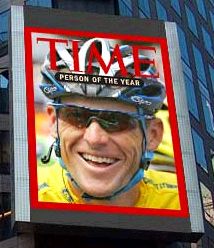
Time magazine is allowing anyone to submit photos of people they want to be “Person of the Year” to be projected on a billboard in Times Square. However, the website states that what they really want is to have people submit photos of themselves. All the photos that are selected to be projected will be photographed by webcam and their owners will be contacted. The images can be viewed, printed and sent to friends.
If the chance of seeing your image on a giant billboard in Times Square in real time is small, what is the difference between having Time photoshop your face onto its cover and doing it yourself? Is it the idea of projecting your image onto a billboard (which can be simulated as well)?
Is this Time magazine diminishing their role as information filter or it is an established news outlet recognizing the idea that anyone can be a publisher?
premature burial, or, the electronic word in time and space
We were talking yesterday (and Bob earlier) about how to better organize content on if:book – how to highlight active discussion threads, or draw attention to our various categories. Something more dynamic than a list of links on the sidebar, or a bunch of hot threads advertised at the top. A significant problem with blogs is the tyranny of the vertical column, where new entries call out for attention on a stack of rapidly forgotten material, much of which might still be worth reading even though it was posted back in the dark ages (i.e. three days ago). Some of the posts that get buried still have active discussions stemming from them. Just today, “ways of seeing, ways of writing” – posted nearly two weeks ago – received another comment. The conversation is still going. (See also Dan’s “blog reading: what’s left behind”.)
This points to another thorny problem, still unsolved nearly 15 years into the world wide web, and several years into the blogging craze: how to visualize asynchronous conversations – that is, conversations in which time lapses between remarks. If the conversation is between only two people, a simple chronological column works fine – it’s a basic back-and-forth. But consider the place where some of the most dynamic multi-person asynchronous conversations are going on: in the comment streams of blog entries. Here you have multiple forking paths, hopping back and forth between earlier and later remarks, people sticking close to the thread, people dropping in and out. But again, you have the tyranny of the vertical column.
We’re using an open source platform called Drupal for our NextText project, which has a blog as its central element but can be expanded with modular units to do much more than we’re able to do here. The way Drupal handles comments is nice. You have the usual column arranged chronologically, with comments streaming downward, but readers have the option of replying to specific comments, not just to the parent post. Replies to specific comments are indented slightly, creating a sort of sub-stream, and the the fork can keep on going indefinitely, indenting rightward.
This handles forks and leaps fairly well, but offers at best only a partial solution. We’re still working with a print paradigm: the outline. Headers, sub-headers, bullet points. These distinguish areas in a linear stream, but they don’t handle the non-linear character of complex conversations. There is always the linear element of time, but this is extremely limiting as an organizing principle. Interesting conversations make loops. They tangle. They soar. They sag. They connect to other conversations.
But the web has so far been dominated by time as an organizing principle, new at the top and old at the bottom (or vice versa), and this is one the most-repeated complaints people have about it. The web favors the new, the hot, the immediate. But we’re dealing with a medium than can also handle space, or at least the perception of space. We need not be bound to lists and outlines, we need not plod along in chronological order. We could be looking at conversations as terrains, as topographies.
The electronic word finds itself in an increasingly social context. We need to design a better way to capture this – something that gives the sense of the whole (the big picture), but allows one to dive directly into the details. This would be a great challenge to drop into a design class. Warren Sack developed a “conversation map” for news groups in the late 90s. From what I can tell, it’s a little overwhelming. I’m talking about something that draws people right in and gets them talking. Let’s look around.

